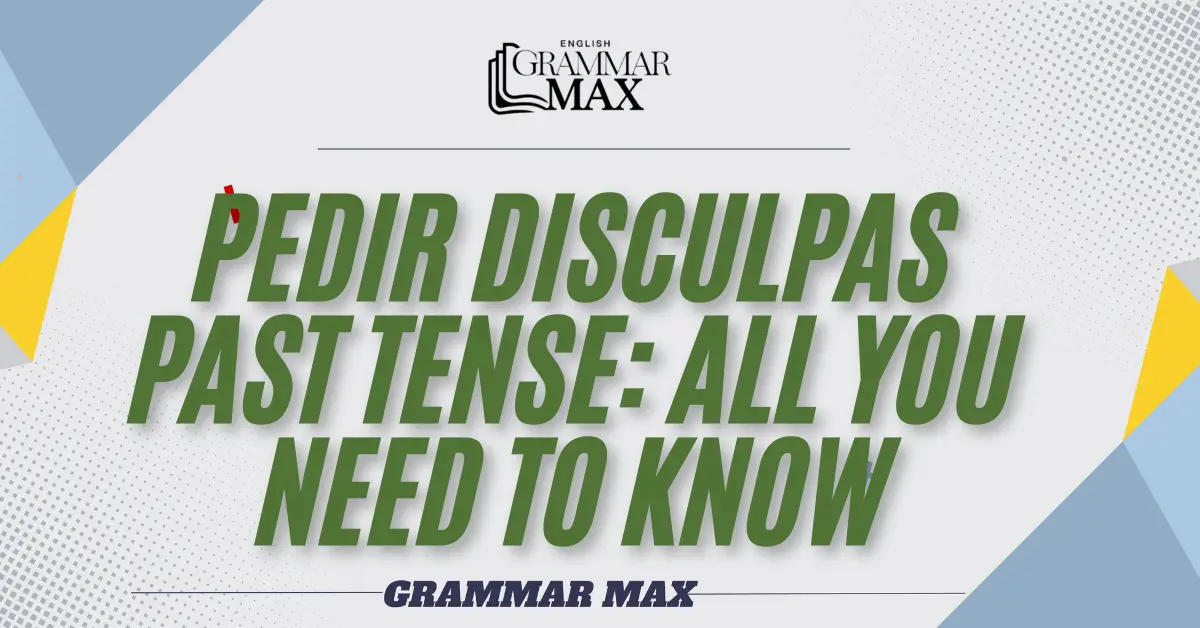Mastering Spanish requires understanding different tenses, especially for phrases like “pedir disculpas” (to apologize). This expression comes in handy for both formal and casual settings, helping you convey your apologies effectively.
We’ll break down how to use pedir disculpas in the past tense and guide you on how to sound sincere in Spanish when referring to past actions. With this knowledge, you’ll be prepared to apologize in a way that resonates in both personal and professional contexts.
Understanding Pedir Disculpas Past Tense
The phrase “pedir disculpas” directly translates to “ask for apologies.” When you use it in the past tense, it allows you to express regret for something that happened before the current moment. The way you conjugate this phrase changes based on whether the apology is a single event or a repeated one. Spanish has two main past tenses for apologies: the Preterite and Imperfect tenses. Knowing when to use each one helps create a more meaningful apology that sounds natural in various settings.
In Spanish, using the past tense in apologies adds weight, especially when recounting an event. The Preterite tense is ideal for one-time actions, such as “Pedí disculpas” (I apologized). The Imperfect tense, on the other hand, suits apologies for recurring actions or apologies meant to express a sense of ongoing regret.
Past Tense Forms Explained
In Spanish, you’ll often need to choose between Preterite and Imperfect forms based on the specifics of the apology. When something happened just once and is now completed, the Preterite is perfect. This is common for apologies about specific incidents. Meanwhile, the Imperfect tense works for apologies in contexts where the regret is ongoing or habitual as if the apology needs to be continually acknowledged. This distinction is key, as it conveys not only the event but also the speaker’s attitude toward the situation.
Let’s look at an example: if someone says, “Pedía disculpas cada día” (I used to apologize every day), it suggests a recurring regret. In contrast, “Pedí disculpas ayer” (I apologized yesterday) is a one-time action, making the apology feel complete and resolved.
Pedí Disculpas: Simple Past Form
Pedí disculpas uses the Preterite tense, which emphasizes an action completed in the past. This phrase is commonly used in casual or formal situations to acknowledge a specific moment when you apologize. Imagine explaining why you missed a meeting: “Pedí disculpas por no asistir” (I apologized for not attending). It shows you addressed the issue and took responsibility, leaving no ambiguity.
In conversations, this phrase works well in a variety of settings, from personal to business. Saying “pedí disculpas” adds finality, showing the listener that the apology occurred and was resolved.
Common Scenarios for Apologies
Personal Relationships
Apologies are a vital part of personal relationships. Using past tense in “pedir disculpas” makes these expressions more meaningful and heartfelt. When discussing a specific incident with a friend, you might say, “Pedí disculpas por llegar tarde a la cena” (I apologize for being late to dinner).
This communicates that you took responsibility for a past mistake. In relationships, using the Preterite tense shows you acknowledge what went wrong without leaving the issue open-ended.
Professional Settings
In a professional setting, apologies often occur after missed deadlines or misunderstandings. Using the right tense here is essential. For instance, “Pedí disculpas a mi jefe por el retraso” (I apologized to my boss for the delay) is formal, sincere, and respectful. In work environments, a completed apology carries weight, especially if it’s clear you won’t repeat the mistake.
Examples of Past Apologies
To see how past apologies work in context, consider these examples. Each phrase uses the Preterite tense to show a completed apology, making it suitable for different scenarios:
Here’s a table with the sentences translated:
| Spanish Sentence | English Translation |
|---|---|
| Pedí disculpas por la confusión en el correo. | I apologized for the confusion in the email. |
| Pedí disculpas a mi amigo por no llamarlo. | I apologized to my friend for not calling. |
| Pedí disculpas en la reunión por mi error. | I apologized in the meeting for my mistake. |
These sentences cover various professional and personal situations. They also reflect a single moment of apology, making the action clear and well-defined.
Tips for Effective Apologies
Showing Genuine Remorse
One way to make apologies effective is by showing genuine remorse. In Spanish, expressing sincerity often involves specific phrases or the way an apology is delivered. Saying “lo siento de verdad” (I truly apologize) adds depth to “pedí disculpas.” Including an explanation, such as “Pedí disculpas porque me equivoqué” (I apologized because I made a mistake), strengthens your apology.
In both professional and personal contexts, remorse is a cultural value, as it emphasizes respect for the other person’s feelings. Showing regret sincerely often means the difference between a simple statement and a heartfelt apology.
Pedir in the Subjunctive Future Perfect
The Subjunctive Future Perfect form of “pedir” is rare but essential in Spanish. It’s used in situations where an apology might occur in the future under specific conditions. For example, “Si hubiera sabido, habría pedido disculpas” (If I had known, I would have apologized) shows an apology that would have happened if conditions were different.
The Subjunctive Future Perfect conveys an apology’s conditional nature, making it sound diplomatic. It’s commonly used in meetings or discussions where professionalism and politeness are essential.
Imperative Tenses of Pedir
Pedir in the Imperative Affirmative
The imperative tense of “pedir” is used when instructing someone to apologize. For example, “Pide disculpas a tu colega” (Apologies to your colleague) is both direct and polite. This form can be used in formal conversations or work environments where issuing polite instructions is necessary.
The affirmative imperative also has variations based on formality, such as “Pida disculpas, por favor” (Please apologize) in a respectful tone. Using this tense helps maintain boundaries while making expectations clear in situations requiring assertive communication.
Example Sentences and Usage
To reinforce learning, here’s a table with different forms of “pedir disculpas” in various tense contexts:
| Form | Spanish Phrase | English Translation |
| Preterite | Pedí disculpas | I apologized |
| Imperfect | Pedía disculpas cada vez | I used to apologize each time |
| Subjunctive Future | Habría pedido disculpas | I would have apologized |
| Imperative (Formal) | Pida disculpas | Please apologize |
These examples show how changing tenses affects both the meaning and sincerity of an apology.
Frequently Asked Questions
What is the past tense for Pedir?
The past tense for pedir (to ask) is pedí (I asked) in the Preterite form.
What does pedir disculpas mean?
Pedir disculpas means to apologize or to ask for forgiveness in Spanish.
How do you say “I apologized” in Spanish?
To say “I apologized” in Spanish, use the phrase “Pedí disculpas.”
When should I use the Preterite tense for pedir disculpas?
Use the Preterite tense for pedir disculpas to indicate a completed action a specific apology made at a particular time.
Conclusion
In any language, knowing how to apologize well is crucial, and Spanish is no exception. Mastering the past tense forms of “pedir disculpas” equips you to handle personal and professional conversations with respect and sincerity.
Whether it’s a single apology or an ongoing expression of regret, choosing the right form strengthens your communication. Practicing these tenses ensures you’re prepared for conversations where clarity and politeness matter.

William Henry is a writer for Grammar Max, a blog that focuses on synonyms and phrases. He loves exploring the quirks of the English language and enjoys helping readers improve their vocabulary. William’s articles are easy to read, fun, and full of useful tips for anyone looking to better understand and use English. Whether you’re a student, a professional, or just someone interested in language, William’s writing on Grammar Max makes learning about words and their meanings simple and enjoyable.















